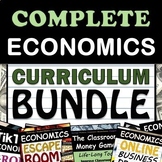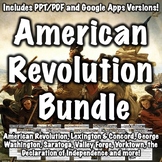19 results
11th grade criminal justice - law lectures for Microsoft Word

Forensic Toxicology Guided Notes and Review Questions (Digital Resource)
This is the best way to introduce one of the BEST units in Forensic Science: Forensic Toxicology! The study of drugs and poisons is so important and applicable to your students. This unit is interesting, engaging, and can lead to many great discussions about the changes in laws surrounding drugs and poisons. This student note sheet is perfect for use with my "Forensic Toxicology Slideshow"At the end of the guided notes, you will receive a BONUS item for this unit! The "Unit Review Questions" con
Subjects:
Grades:
9th - 12th
Types:
CCSS:
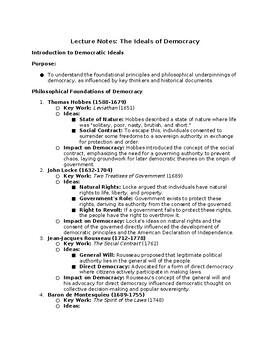
Ideals of Democracy: American Independence, War, and Constitution Lecture Notes
Using Lecture Notes on Democratic Ideals and the American Revolution in Social Studies CoursesPurpose:To provide a comprehensive framework for teaching key concepts in civics, AP Government, U.S. Government, Constitutional Law, Law Studies, or other applicable social studies courses using the lecture notes on democratic ideals and the American Revolution.Integrating the Lecture NotesCivics and Middle School Social StudiesIntroduction to Fundamental Concepts:Democratic Ideals: Use the lecture not
Subjects:
Grades:
5th - 12th, Higher Education
Types:

Branches of Government and Bureaucracy Lecture notes
Using Lecture Notes in High School Government, Law Studies, or Middle School Civics ClassesOverviewThe lecture notes on Article One (Legislative Branch), Article Two (Executive Branch), Article Three (Judicial Branch), and the Bureaucracy provide a comprehensive framework for teaching students about the structure and functions of the U.S. government. Here’s how a teacher can integrate these notes into their curriculum:Lesson Planning and Implementation1. Introduction to the Constitution and Gove
Subjects:
Grades:
6th - 12th
Types:
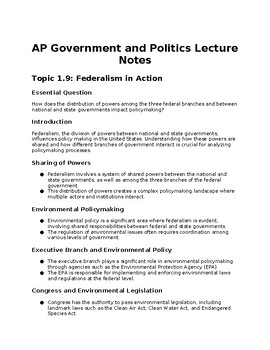
AP Government 1.9: Federalism in Action Lecture Notes
Using these lecture notes can greatly assist a teacher in preparing their students for success on the AP Government and Politics exam by providing a comprehensive understanding of federalism in action and its implications for policymaking. Here's how:1. Addressing Key Concepts:Comprehensive Coverage: The lecture notes cover essential topics such as the distribution of powers, environmental policymaking, branches of government roles, and conflicts between branches. This ensures that students have
Subjects:
Grades:
6th - 12th
Types:
Also included in: AP Government and Politics Unit One Lecture Bundle: Topics 1.1-1.9
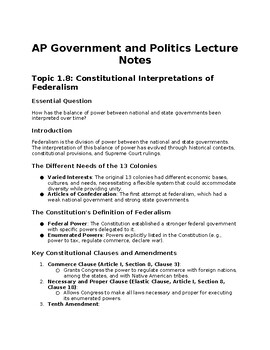
AP Government 1.8 Constitutional Interpretations of Federalism Lecture Notes
Lesson Planning:1. Introduction:Start the lesson by presenting the essential question: "How has the balance of power between national and state governments been interpreted over time?"Provide a brief overview of federalism and its importance in the U.S. Constitution.2. Main Content Delivery:Utilize the lecture notes to explain the various aspects of constitutional interpretations of federalism, including:Different needs of the 13 colonies.Constitution's definition of federalism and key provision
Subjects:
Grades:
6th - 12th
Types:
Also included in: AP Government and Politics Unit One Lecture Bundle: Topics 1.1-1.9
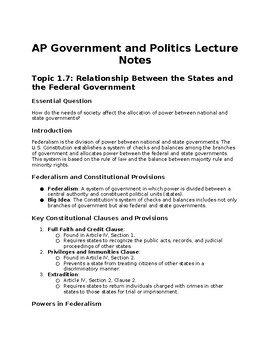
AP Government Topic 1.7 Relationship Between the States and the Federal Gov't
How a Teacher Could Use These Lecture Notes in Instruction: Topic 1.7Lesson PlanningStructure the Lesson:Introduction: Begin with the essential question to frame the lesson.Background: Provide an overview of federalism and its significance in the U.S. Constitution.Main Content: Cover key constitutional clauses, types of powers, and fiscal federalism.Case Studies: Use historical and modern examples to illustrate concepts.Conclusion: Summarize key points and revisit the essential question.Detailed
Subjects:
Grades:
6th - 12th
Types:
Also included in: AP Government and Politics Unit One Lecture Bundle: Topics 1.1-1.9

AP Government Lecture Notes 1.6: Principles of American Government
How a Teacher Could Use These Lecture Notes in InstructionLesson PlanningStructure the Lesson:Introduction: Start with the essential question to guide the lesson's focus.Background: Provide context on the Framers' intentions and the foundation of the principles of separation of powers and checks and balances.Main Content: Discuss the three branches of government, key concepts, and mechanisms of checks and balances.Federalist and Anti-Federalist Views: Present excerpts from Federalist Paper No. 5
Subjects:
Grades:
6th - 12th
Types:
Also included in: AP Government and Politics Unit One Lecture Bundle: Topics 1.1-1.9

Lecture Notes 1.5: Ratification of the Constitution AP Government and Politics
How a Teacher Could Use These Lecture Notes in Instruction Lesson Lesson PlanningStructure the Lesson:Introduction: Start with the essential question to guide the lesson's focus.Background: Provide context on the Constitutional Convention and differing plans.Main Content: Discuss the key compromises and the ratification process.Modern Relevance: Connect historical debates to modern constitutional issues.Conclusion: Summarize the key points and revisit the essential question.Detailed Lesson Plan:
Subjects:
Grades:
6th - 12th
Types:
Also included in: AP Government and Politics Unit One Lecture Bundle: Topics 1.1-1.9
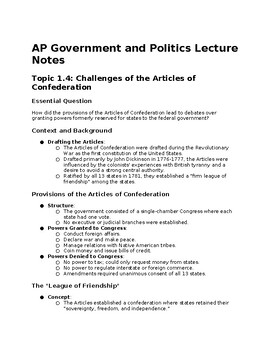
Lecture Notes AP Government 1.4: Challenges of the Articles of Confederation
Lesson PlanningStructure the Lesson:Introduction: Start with the essential question to guide the lesson's focus.Background: Provide context on the drafting of the Articles to set the stage for understanding why the Articles were created and what they intended to achieve.Main Content: Discuss the key provisions and weaknesses of the Articles.Case Study: Use Shay's Rebellion as a concrete example of the Articles' failures.Debate and Conclusion: Facilitate a discussion on the debates over granting
Subjects:
Grades:
6th - 12th
Types:
Also included in: AP Government and Politics Unit One Lecture Bundle: Topics 1.1-1.9
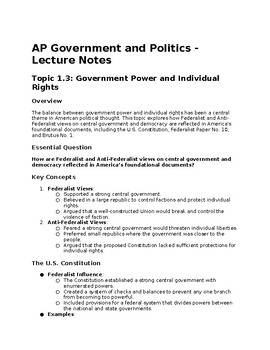
AP Government and Politics 1.3 Government Power Individual Rights Notes
OverviewThe balance between government power and individual rights has been a central theme in American political thought. This topic explores how Federalist and Anti-Federalist views on central government and democracy are reflected in America's foundational documents, including the U.S. Constitution, Federalist Paper No. 10, and Brutus No. 1.Essential QuestionHow are Federalist and Anti-Federalist views on central government and democracy reflected in America’s foundational documents?The tensi
Subjects:
Grades:
6th - 12th
Types:
Also included in: AP Government and Politics Unit One Lecture Bundle: Topics 1.1-1.9
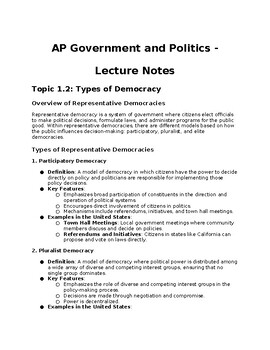
AP Government Topic 1.2: Types of Democracy Lecture notes and Activities
Guide for Teachers: Using Lecture Notes and ActivitiesIntroductionThese lecture notes and activities are designed to help students understand the three types of representative democracies—participatory, pluralist, and elite democracies—and the tensions that arise from these models. The structured approach ensures comprehensive coverage of AP Government and Politics Topic 1.2 and fosters active learning and critical thinking.Using the Lecture NotesIntroduction to the Topic:Begin the lesson with a
Subjects:
Grades:
6th - 12th, Higher Education, Adult Education
Types:
Also included in: AP Government and Politics Unit One Lecture Bundle: Topics 1.1-1.9

Criminal Law - Defense to Crimes Student Guided Notes
These guided notes accompany Criminal Law - Defenses to Crimes PowerPoint presentation also located in this TPT store.Learning Targets Include:List the three elements of self-defense.Describe when deadly force may be used in self-defense.Name two situations in which a first aggressor can claim self-defense.Describe the circumstances in which a person can use force to defend property.Explain when a police officer may use deadly force in effecting an arrest or preventing escape.List five tests for
Subjects:
Grades:
9th - 12th, Higher Education, Adult Education

The Fast Food Debate! Five Days of Lessons, 10 Minutes of Preparation TOTAL!
Unbeatable Value and great quality- we've done the hard work so you don't have to! A quick download, some printing, cue a video (link provided) and you are set.Teach students debate skills, critical thinking skills, and logical skills to help with essay writing with an extended unit.This is a fun, engaging classroom activity that students always take seriously and learn a lot from. The first two lessons are instructional, critical viewing of hilarious debates with practice applications of skill
Grades:
10th - 12th
Types:
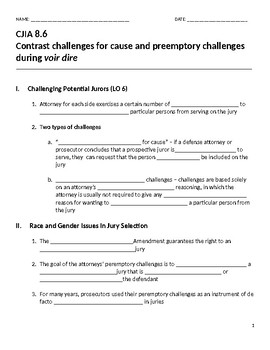
Student Notes: Challenges for Cause and Preemptory Challenges during Voir Dire
Guided Notes for Criminal Justice in Action Unit 8.6
Subjects:
Grades:
9th - 12th, Higher Education, Adult Education
Types:

Teacher Guide: Challenges for Cause and Preemptory Challenges during Voir Dire
Teacher Guide for: Challenges for Cause and Peremptory Challenges during Voir Dire
Subjects:
Grades:
9th - 12th, Higher Education, Adult Education

Foundations of Laws and Values Student Handout
This handout is to be used in conjunction with the powerpoint "Foundations of Laws and Values."
Subjects:
Grades:
7th - 12th
Types:

A Brief History of Law
These lecture notes/transparencies are designed to introduce grade 11 law students to the history that shaped our current legal system. Hammurabi's code, Mosaic Law, Greek Law, Roman Law, and British Law up to the Magna Carta are explained briefly, but in a way that links the past to the present. Keywords are bolded to remind students that they have significance to the law today.
Grades:
9th - 12th
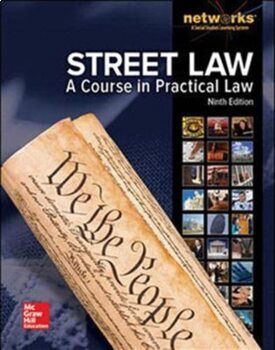
STREET LAW: A COURSE IN PRACTICAL LAW:CHAPTER 1: WHAT IS LAW QUESTIONS WITH TEST
Street Law, Chapter 1 , What is Law? questions and Easel Assessment coincide with the 9th Edition of the Street Law text. The questions can be used with earlier or later versions of the text with minimal changes to the topics or questions. I have developed my own set of questions and assessments as an addition to the resources available through the Street Law text. The questions can be an organizing tool for the teacher and the student that may have difficulty with chapter reading. The qu
Subjects:
Grades:
9th - 12th
Types:

Criminal Law Lecture Notes
This is a 4 page document with a summary of criminal law used for a business law class. It is a short summary of information to introduce business students to some of the more important aspects of criminal law. The lecture includes the classification of crimes, crimes categorized by person and property, and white collar crimes. It also has a short review of the constitutional elements involved including 4th, 5th, 6th and 8th amendment rights along with a short discussion of the exclusionary ru
Grades:
9th - 12th, Higher Education, Adult Education
Types:
Showing 1-19 of 19 results

